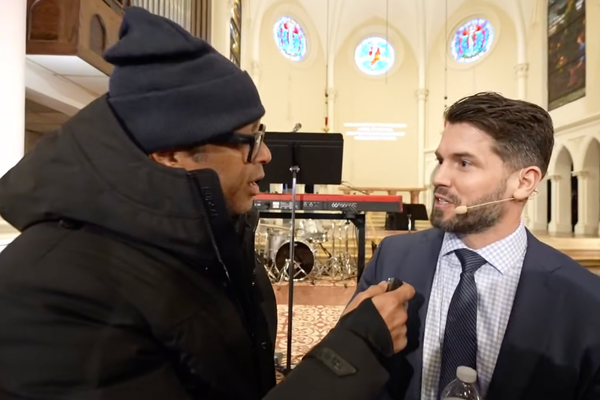
The worn wooden panels squeak under Rafael Molina’s heavy steps as he paces the saloon. Outside, the sound of a few loose galloping horses resonates from afar, breaking the silence of the surrounding desert. The town’s empty shops and abandoned storehouses look as if they have been ransacked by a band of cowboy bandits. “When I was a kid I could only dream about all this,” says the 68-year-old with undisguised pride. “At that time, my only aspiration was to see a film set first-hand. Today I am the owner of one of the most famous ones in the history of western movies.”

Rafael Molina, 68, a former stuntman and actor, now the owner of Fort Bravo
A former actor and stuntman, Molina bought Fort Bravo at the end of the 70s. Nowadays this western film set is one of the busiest in the world, one of three located around the small town of Tabernas and its homonymous desert, in the Spanish province of Almería. In past decades, these rugged mountains, arid plains and dry canyons have served as shooting ground for more than 170 westerns, including masterpieces such as the The Good, the Bad and the Ugly and Once Upon a Time in the West.
Molina started his cinema career in the mid-70s, when he showed up uninvited on the set of Take a Hard Ride, hoping for a job. The movie was being shot in the Canary Islands, but Molina’s fascination with westerns was such that he burned all his savings for a plane ticket to get there. “I did all sorts of jobs on the set: labourer, painter, bricklayer, and finally horseman,” he remembers fondly. “At the end of the shooting I stayed in the Canary Islands for six more months, working menial jobs to gather enough money for the return ticket.”

A horsewoman training a young Andalusian horse in the streets of Oasys Mini Hollywood, a western-styled movie set
Molina belongs to a small, fascinating community of local cowboys and stuntmen who have constantly been featured in movies and shows since the advent of the first productions in the 50s. Among the world’s best in their profession, they can perform anything from fistfights to horse drags and high-level falls. Most of them prefer to pass on their knowledge and skills from father to son, to keep the tricks of the trade within their family. Imbued in the classics of the European westerns’ golden era, they personify the values of their movie heroes: pride, bravado, freedom and a symbiotic relationship with horses.

Ricardo Cruz Fernández (left) and Rafael Aparicio García are two professional stuntmen who have featured in several movies and music videos; they regularly work for Fort Bravo sets
“I’ve always liked horses and the far west,” says Ricardo Cruz Fernández, 29, a stuntman and cowboy who has appeared in recent productions such as Game of Thrones, Ridley Scott’s Exodus: Gods and Kings and The Sisters Brothers, a 2018 Franco-American western starring Joaquin Phoenix. Fernández started his career as a cowboy after completing a stuntman course 10 years ago. Between productions, he performs daily shows at Fort Bravo for the thousands of western aficionados who visit the set every year. “I prefer to play the bad guy, because it gives me a wider range of possibilities. The good guy only has to keep things in order,” laughs Cruz Fernández.

Stuntman Ricardo Cruz Fernández, 29, in the main street in Fort Bravo
Cruz Fernández’s romance with the wild west started as a kid, after he fell in love with the Dollars trilogy – A Fistful of Dollars, For a Few Dollars More, and The Good, the Bad and the Ugly – by the Italian director Sergio Leone, starring a young and still unknown Clint Eastwood as The Man with No Name. The films were all shot in the province of Almería.


“Leone’s movies didn’t need many dialogues or intricate plots. The actors’ gestures, the music and the little details are enough to give you goosebumps,” explains Cruz Fernández. Thanks to its innovative shooting style and skilful balance of images and captivating soundtrack, the trilogy was at the forefront of “spaghetti westerns”, a broad sub-genre that became extremely popular in the 60s and 70s. Most of its directors were Italians, while producers and especially actors were an intricate blend of Italians, Spaniards and Americans, all acting in their own language.

The ruins of the movie set of El Condor, a western movie shot in the 70s


Snubbed by American critics at first, spaghetti westerns nonetheless became hugely successful thanks to the foreign, disenchanted vision they brought to a genre that had almost disappeared in America at that time. The wild west they depicted was a far cry from the epic of white conquest portrayed in the American classics. Their main characters were not champions of the defenceless, but amoral bounty hunters moved by personal profit, greed and vengeance. Actions and violence ruled, and the good rarely triumphed.

Panoramic view of the Tabernas desert, where the western movie sets are located
Although Almería had already been used as a shooting venue for a few renowned movies – among them Lawrence of Arabia and Cleopatra – it was Leone, and the ensuing flurry of European westerns, that finally brought the province’s stunning light and natural sets into the international spotlight. Since then, Almería has hosted more than 500 film productions, including blockbusters, and renowned TV series, from Patton to Terminator: Dark Fate and Doctor Who. “Our landscapes are very convenient. We have sea, desert and snow mountains all within a short distance,” says local producer Plácido Martínez. “We can serve as Texas, New Mexico, Arizona, California and endless other natural settings.”

Horses running wild in Fort Bravo
When foreign western productions discovered Almería in the 60s, the province was one of the poorest in Spain, plagued by high unemployment and emigration. Despite its remoteness, production costs were extremely low and its inhabitants were skilled horsemen. Mostly dark-skinned, they were ideal stuntmen and extras for spaghetti westerns set on the border between the US and Mexico. “I was earning more money in one day than my father in one week of hard labour in the goldmine,” remembers Manuel Hernández Montoya, a 61-year-old hotel owner who worked as extra in several westerns when he was a child.

Manuel Hernández Montoya, a 61-year-old former actor who played in spaghetti westerns in his childhood, stands on the ruins of Cortijo del Fraile, used in several famous films
In the years that followed the success of A Fistful of Dollars, two open-air western sets – currently named Oasys Mini Hollywood and Western Leone – were built around Tabernas. The region hardly had any paved road at that time, and the cinema industry was instrumental in building Almería’s airport and first hotels. In just a few years, the city turned from a backwater to a European version of Hollywood, with celebrities such as Claudia Cardinale, Alain Delon and Charles Bronson sipping drinks by the Grand Hotel pool between shootings.

Professional stuntman preparing a pile of hay before the show starts at Oasys Mini Hollywood

A stuntman carrying hay on his back at the end of the working day
The movie industry also boosted the international image of Francisco Franco, the dictator ruling Spain at that time. “The regime was very happy to welcome celebrities such as Ava Gardner, Frank Sinatra or John Wayne,” says Evaristo Martínez, an Almería-based journalist and cinema expert. “Franco would facilitate international productions in any way, even those whose movies were censored locally.”

Three professional stuntmen walk around Fort Bravo with their horses – all have appeared in several international movie productions
The spaghetti western genre declined in the second half of the 70s due to overproduction, a sustained dip in quality and shifting interest from the public. The setback was a heavy blow for the local cinema industry. Thousands of jobs were lost and the western decors fell into disrepair. Abandoned by their owners, they were kept functioning by a few stuntmen, who started offering western shows for tourists in order to make ends meet. When Molina bought Fort Bravo for just $6,000, the decor was in ruins. It took him months of hard labour to bring it back to its former splendour.
After hosting a few big productions in the 80s – including Indiana Jones and the Last Crusade and Conan the Barbarian, the movie that launched Arnold Schwarzenegger’s international career – Almería’s cinema industry picked up again in the following decade. Westerns would never regain the prominence of the golden years, but locals still feel deeply bound to them. “Western movies have definitely changed the fate of our province, from the 50s up until now,” continues Martínez, the producer. “In the past eight years they have enjoyed a huge revival all over the world.”

A French can-can show performed at the saloon in Oasys Mini Hollywood
Every year, Tabernas holds a western festival that attracts thousands of visitors from every corner of the world. Specialised tour agencies guide visitors through the remote canyons and mountains where their favourite movies were shot. “I once had a tourist who came all the way from Japan just to take selfies in every location of the trilogy wearing Clint Eastwood’s poncho,” remembers Cristina Serena Seguí, manager of the Malcamino’s agency.
Nowhere is the connection between westerns and Almería more striking than on the sets’ dusty roads. To stand amid these old wooden houses, discoloured by the burning sun and beaten by mountain winds, is a unique experience. It brings us into a timeless past, back to the adventurous cowboys’ world we all dreamed about when we were kids.
Despite its roughness, the wild west’s image of a free and simple society is an alluring alternative to our hyper-regulated modern world, made of countless rules and limitations. “Western movies are so successful because everyone can understand them. You kill me, I kill you,” says Molina. “There are no politics, no systemic injustice involved, and those who do something bad must pay. That’s very different from those movies about Wall Street millionaire gangsters operating within the law. What message do they send to society?”

Stuntmen playing a western movie scene at Oasys Mini Hollywood set
Western movies’ simplicity and universal values are one of the reasons why they will never go out of fashion. Quentin Tarantino’s movies are filled with references to the genre, and two of his more recent films, Django Unchained and The Hateful Eight, can be considered modern spaghetti westerns. “Western movies tell the creation of a country and a society from scratch. They represent the history of mankind,” adds Martínez, the producer. Discovered by a bunch of visionary directors and dirty, dusty cowboys, Almería underwent the same metamorphosis described in those films, becoming a modern, real-life homage to the wild west.
Although Almería’s fame as a shooting destination has gone well beyond westerns – Black Mirror, Blade Runner 2049 and Wonder Woman 1984 were all shot here recently – its western sets still host dozens of productions every year. “I don’t think I will ever be able to retire,” says Molina, laughing. “That’s OK to me, because it would mean giving up my happiness.”
Molina ended acting long ago, after an almost fatal accident forced him to choose between his family and his beloved career. Yet he reckons he will never be able to quit Fort Bravo. A manly and passionate dreamer, he blends perfectly in the suspended atmosphere of this imaginary frontier town, where man and wild nature are one. “I used to spend my summer nights here, right at the centre of the Mexican square,” he concludes with wet eyes. “I would lay down on my back and watch the sky. There are so many stars it is impossible to count them all.”







